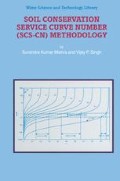Abstract
Long-term hydrologic simulation is required for augmentation of hydrologic data. It is useful for water resources planning and watershed management. Long-term hydrologic data are specifically required for analyses of water availability; computation of daily, fortnightly, and monthly flows for reservoir operation; and drought analyses. Since the rainfall data are generally available for a much longer period than are the stream flow data, long-term hydrologic simulation helps extend the gauged data required for the above applications. Since this book deals with the SCS-CN method, the available methods utilizing the SCS-CN method for hydrologic simulation are reviewed and their application is demonstrated using simple examples. Finally, the modified version of the SCS-CN method (Chapter 4) along with its variants is applied to the data set of Hemavati watershed (area = 600 sq. km) in India.
Access this chapter
Tax calculation will be finalised at checkout
Purchases are for personal use only
Preview
Unable to display preview. Download preview PDF.
References
Burton, J. S. Compiler (1993), Proceedings of the Federal Interagency Workshop on Hydrologic Modeling Demands for the 90‘s, U. S. Geological Survey Water Resources Investigations Report 934018, Federal Center, Denver, Colorado.
Haan, C.T. (1975), ‘Evaluation of a model for simulating monthly water yields from small watersheds,’ Southern Cooperative Series Bulletin 201, Agricultural Experiment Stations of Kentucky, Mississippi, North Carolina, South Carolina, Tennessee, and Virginia, July.
Hawkins, R.H. (1978), ‘Runoff curve numbers with varying site moisture,’ J. Irrig. and Draing. Div., A.S.C.E., Vol. 104 (IR4), pp. 389–398.
HEC (2000), ‘Hydrologic modeling system HEC-HMS,’ User‘s manual, version 2, Hydrologic Engineering Center, U. S. Army Corps of Engineers, Davis, California.
Holtan, H.N. and N.C. Lopez (1971), ‘USDHAL-70 model of watershed hydrology,’ U.S.D.A., Tech. Bull. 1435.
Huber, W.C., J.P. Heaney, B.P. Bedient, and J.P. Bender (1976), ‘Environmental resources management studies in the Kissimmee river basin,’ Rep. No. ENV–05–76–3, Dept. of Envir. Engrg., Univ. of Florida, Gainesville, Fla, May.
Knisel, W.G. (1980), ‘CREAMS, A field-scale model for chemicals, runoff, and erosion from agricultural management systems,’ Conservation Rep. No. 26, U.S.D.A. Agriculture Research Service, Washington D.C.
Mishra, S.K., N.K. Goel, S.M. Seth, and D.K. Srivastava (1998), ‘An SCS-CN-based long-term daily flow simulation model for a hilly catchment,’ Int. Symp. ‘Hydrology of Ungauged Streams in Hilly Regions for Small Hydro Power Development,’ Mar. 9–10, New Delhi, India.
Nash, J.E. and J.V. Sutcliffe (1970), ‘River flow forecasting through conceptual models, Part I-A discussion of principles,’ J. Hydrology, Vol. 10, pp. 282–290.
Pandit, A. and G. Gopalakrishnan (1996), ‘Estimation of annual storm runoff coefficients by continuous simulation,’ J. Irrigation and Drainage Engineering, Vol. 122, No. 4, pp. 211–220.
Ponce, V.M. (1989), ‘Engineering Hydrology: Principles and Practices,’ Prentice Hall, Englewood Cliffs, New Jersey.
Ponce, V.M. and R.H. Hawkins (1996); Runoff curve number: Has it reached maturity?,’ J. Hydrologic Engrg., A.S.C.E., Vol. 1, No. 1, pp. 11–19.
Schaake, J.C., V.I. Koren, Qing-Yun Duan, K.Mitchell, and F. Chen (1996), ‘Simple water balance model for estimating runoff at different spatial and temporal scales,’ J. Geophysical Research, Vol. 101, No. D3, pp. 7461–7475.
Singh, V. P. (editor) (1995), ‘Computer models of watershed hydrology,’ Water Resources Publications, Littleton, Colorado.
Singh, P. and V.P. Singh (2001), ‘Snow and Glacier Hydrology,’ Kluwer Academic Publishers, P.O. Box 322, Dordrecht, The Netherlands.
Singh, R.D., S.K. Mishra, and H. Chowdhary (2001), ‘Regional flow duration models for 1200 ungauged Himalayan watersheds for planning micro-hydro projects,’ J. Hydrologic Engineering, Technical Note, A.S.C.E., Vol. 6, No. 4, July/August.
Singh, V.P. (1992), ‘Elementary Hydrology,’ Prentice Hall, Englewood Cliffs, New Jersey.
Singh, V.P. and F.X. Yu (1990), ‘Derivation of infiltration equation using systems approach,’ J. Irrigation and Drainage Engineering, A.S.C.E., Vol. 116, No. 6, pp. 837–857.
Soni, B. and G.C. Mishra (1985), ‘Soil water accounting using SCS hydrologic soil classification,’ Case Study, National Institute of Hydrology, Roorkee (India).
Subcommittee on Hydrology (1998), Proceedings of the first federal interagency hydrologic modeling conference, Interagency Advisory Committee on Water, U. S. Geological Survey Reston, Virginia.
Williams, J.R and V. LaSeur (1976); Water yield model using SCS curve numbers,’ J. Hydraulic Engineering, 102 (HY9), pp. 1241–1253.
Woodward, D.E. and W.J. Gburek (1992), ‘Progress report ARS/SCS curve number work group,’ Proc., A.S.C.E. Water Forum ‘92, ASCE, New York, N.Y., 378–382.
Wurbs, R. A. (1998), Dissemination of ‘Generalized water resources models in the United States,’ Water International, 23, pp. 190–198.
Yu, B. (1998), ‘Theoretical justification of SCS-CN method for runoff estimation,’ J. Irrig. and Drain. Engrg., Vol. 124, No. 6, pp. 306–310.
Author information
Authors and Affiliations
Rights and permissions
Copyright information
© 2003 Springer Science+Business Media Dordrecht
About this chapter
Cite this chapter
Mishra, S.K., Singh, V.P. (2003). Long-Term Hydrologic Simulation. In: Soil Conservation Service Curve Number (SCS-CN) Methodology. Water Science and Technology Library, vol 42. Springer, Dordrecht. https://doi.org/10.1007/978-94-017-0147-1_7
Download citation
DOI: https://doi.org/10.1007/978-94-017-0147-1_7
Publisher Name: Springer, Dordrecht
Print ISBN: 978-90-481-6225-3
Online ISBN: 978-94-017-0147-1
eBook Packages: Springer Book Archive

